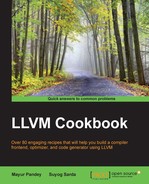In this recipe, you will see how IR code gets generated for an expression using the compiler frontend.
To implement LLVM IR code generation for our TOY language, proceed with the following code flow:
- Open the
toy.cppfile as follows:$ vi toy.cpp
- The function to generate code for numeric values can be defined as follows:
Value *NumericAST::Codegen() { return ConstantInt::get(Type::getInt32Ty(getGlobalContext()), numeric_val); }In LLVM IR, integer constants are represented by the
ConstantIntclass whose numeric value is held by theAPIntclass. - The function for generating code for variable expressions can be defined as follows:
Value *VariableAST::Codegen() { Value *V = Named_Values[Var_Name]; return V ? V : 0; } - The
Codegen()function for binary expression can be defined as follows:Value *BinaryAST::Codegen() { Value *L = LHS->Codegen(); Value *R = RHS->Codegen(); if(L == 0 || R == 0) return 0; switch(atoi(Bin_Operator.c_str())) { case '+' : return Builder.CreateAdd(L, R, "addtmp"); case '-' : return Builder.CreateSub(L, R, "subtmp"); case '*' : return Builder.CreateMul(L, R, "multmp"); case '/' : return Builder.CreateUDiv(L, R, "divtmp"); default : return 0; } }If the code above emits multiple
addtmpvariables, LLVM will automatically provide each one with an increasing, unique numeric suffix.
..................Content has been hidden....................
You can't read the all page of ebook, please click here login for view all page.
